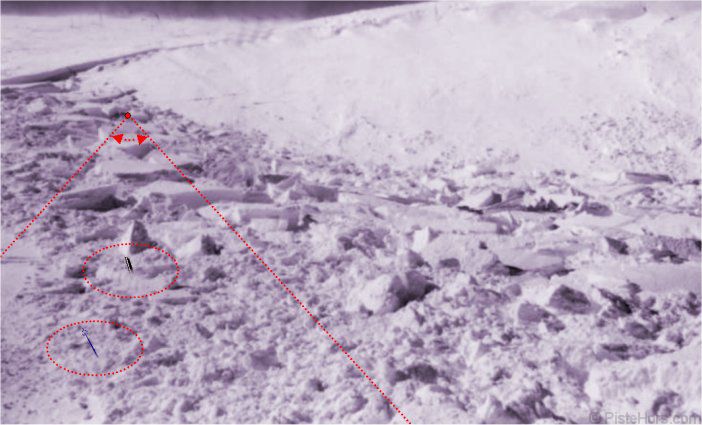
Avalanches > Search and Rescue > Searching for Avalanche Victims > Immediately After The Avalanche Accident
Should an avalanche occur and if you have ve followed the golden rule there should be one or more people able to help with the search and rescue and hopefully only a single victim. Remember that time is vital. While the avalanche is taking place try to follow the skier who is trapped and point to the place where they disappeared under the snow. Look for other clues below this point for where they may have finished up, a ski or stick pointing out the snow may be a good place to start a search. They may also have stopped on a flatter part of the slope, above or below an outcrop, rock or tree. A 60 degree angle from the point where the skier vanished is considered a sweet zone, the avalanche victim will most likely to lie within this area. The effective range of an avalanche transceivers is around a fifth of the maximum range, 10 meters for digital and 20 meters for analogue, so any help in locating the rough area to search is welcome.

Visual Search showing a ski tail and pole and the Sweet Zone
If there is more than one searcher someone should take charge. Rescuers should proceed directly to the avalanche zone, riding off to the side should be avoided as this may provoke a secondary avalanche. Any equipment not of immediate use in the search should be placed at this point to avoid littering the search area with rucksacks, skis etc not associated with the rescue. These may confused rescue dogs if they are needed later.
You may wish to mark the point where the victim disappeared with a ski pole, ski or rucksack. Depending on the conditions someone can act as a spotter to alert for secondary avalanches and this person can also telephone the rescue services with the precise location of the accident. In France it is best to telephone the local Gendarmerie covering the mountain area but the general rescue number (112) can also be used. When the helicopter(s) arrive make a Y signal by holding both arms above your head to indicate that you are the party requesting assistance. Telephone or radio calls should be made away from any avalanche transceivers to avoid interference with the search.
It is important to set all avalanche transceivers to search mode. This includes any bystanders who may have witnessed the avalanche.
The remainder of the group should start the search. The effective number of searchers with transceivers is between 3 to 6, depending on the size of the area avalanched. Other people could begin a probe or audio search around any visual clues spotted on the surface.
A single skier is in a more difficult position. He should phone the rescue services if possible and then immediately start a transceiver based search.
Rescue Service Telephone Numbers in France - FFME
<< Off Piste Conduct | Searching for Avalanche Victims | Primary Transceiver Search >>